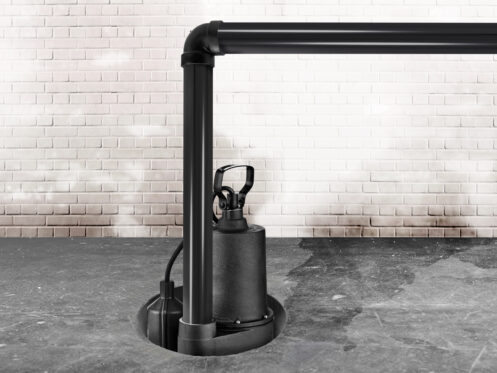Normal sump pump function in your home in Denver, CO is incredibly important for keeping your basement dry and home protected. Periodic maintenance of your sump pump is essential to protect the integrity of the pump and ensure efficiency. These maintenance tips include things you can do yourself, but there isn’t a substitute for professional assistance.
Sump Pump Design and Function
A sump pit is dug into a low point in your basement. A sump pump is installed inside the pit, periodically moving away water that has collected in the pit. There are some key components of a sump pump, including the float switch, check valve, discharge pipe and alarm system. Most homeowners don’t notice this equipment running throughout the day. However, you’ll quickly notice it’s not working if water starts to back up in your basement. This can lead to structural issues, loss of personal belongings and mold growth.
There are different types of sump pumps available, with the most popular ones being a submersible pump and a pedestal pump. A submersible pump is placed inside the pit and functions under the water. It works very quietly, making it ideal in areas of a basement that are near bedrooms or living rooms. A submersible pump also works very well if you have a large volume of water in your pump.
A pedestal sump pump is positioned above the pit and has a motor on the outside. It provides the benefit of easy accessibility when a professional needs to perform routine maintenance or repairs. However, it is a much louder option because of its location outside the pit.
Periodically Testing Your Sump Pump
Once your sump pit fills with water, the pump will engage and move water through a drain line away from your home. You can test this process by pouring water into your pit until it activates the pump. Depending on the type of float switch that your pump has, you may be able to manually lift the arm as though you’re simulating rising water and get it to turn on that way. If the pump doesn’t turn on or the water isn’t discharged completely, reach out to a professional for assistance.
Considering the Power Source
Your sump pump will be plugged into an outlet near your sump pit. In most modern homes, this will be a GFCI outlet. You can test this outlet and circuit breaker to ensure that there is a consistent supply of power available. Press the test button on the outlet. The light on the outlet should go off, and there should be a clicking sound. Pressing the reset button should turn the outlet back on. A professional can use a multimeter to inspect the voltage of the outlet and ensure it is within a safe range.
A professional can also check the electrical connections that are part of your sump pump. This includes wires that connect the pump to the power source.
Cleaning Out Your Sump Pit
Over time, your sump pit will experience an accumulation of dirt, debris and mineral deposits. Having the pit cleaned will prevent any clogs from forming that could impede normal equipment function. This can also help protect the longevity of your sump pump.
Inspection of Your Drainage Pipe
Your sump pit drainage pipe should be free of damage and obstructions to allow water to flow freely through it. This movement of water away from your home prevents your basement from flooding. In the winter months, you may see ice forming on the pipe. Make sure there aren’t signs of ice forming inside the line, such as bulging, cracks on the pipe or slow drainage.
Float Switch Inspection
Part of a professional inspection includes checking the float switch for signs of damage. This part is located on the pump and extends outward, floating freely on the surface of the water. It should move freely and not be obstructed by anything.
Replacement of Parts
Several parts of a sump pump are prone to corrosion over time, requiring replacement. This includes the float switch and the check valve. The impeller and motor may also need to be replaced if your sump pump runs frequently and is many years old.
Considering Backup Batteries
A battery backup system is a great way to keep your sump pump running even when the power goes out. This equipment should be inspected periodically. The battery may need to be refilled with distilled water if the level is low. Inspecting corrosion allows for maintenance or repairs before the battery could fail. The average life expectancy of a backup battery is three to five years. A sump pump usually lasts approximately seven to 10 years, so expect to replace the battery at some point.
If your backup battery has an alarm, make sure it is working. If the power goes out, the alarm will notify you that the backup battery has engaged. There may also be an alarm that alerts you when your pump is malfunctioning. There is usually a test button that you can press to confirm the alarm functions.
Things to Watch Out For
In between routine maintenance appointments, there are things to watch out for that indicate a problem with your sump pump. You’ll want to reach out to a professional if you take note of any of these problems.
Sump Pump Doesn’t Turn Off
If you notice your pump running continuously without turning off, the float switch may be stuck. There may also be a stuck impeller, or your drain line may be clogged and preventing water from draining.
Sump Pump Doesn’t Turn On
If water is rising in your pit but the pump isn’t turning on, electrical issues may be to blame. There may also be a problem with your motor or float switch.
Abnormal Noises
Even a pedestal sump pump should function relatively quietly. If you notice loud sounds coming from your pump, there may be a jammed impeller or worn bearings causing the issue. The fix may be as simple as lubricating a moving part. If you hear gurgling sounds when the pump turns on, a clog may be present that water is attempting to move around.
Frozen Drain Line
If you periodically notice ice on your drain line or it appears that ice is impeding proper drainage, a freeze guard can be installed to prevent future problems. Insulation can also be added to prevent freezing.
Power Failure
If the power is on through the rest of your home but your sump pump doesn’t appear to be powered, there may be an electrical connection that is damaged. There may be an issue with the circuit breaker for that branch, with surges of power causing it to trip frequently.
Summit Heating, A/C, Plumbing & Electrical can help you with sump pump maintenance in your home in Denver. We can also make any necessary repairs and replace your sump pump when the time comes. A professional camera inspection can help our team ensure there aren’t any clogs or problems that could result in water damage. Contact Summit Heating, A/C, Plumbing & Electrical in Denver today to schedule an appointment with our knowledgeable plumbing team.


